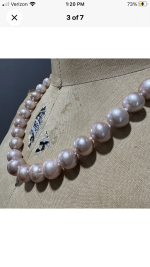Relaxedmallard
Member
- Joined
- Mar 27, 2024
- Messages
- 6
Ok so be easy on me, I already purchased these lol, just am awaiting them to arrive in the mail. I sent an offer quite a bit below selling price and was surprised to find it accepted this morning.
These were listed as Genusis cultured pearls, 11-14mm. My goal was to have some larger pearls with some kind of luster to them on a budget. Currently the largest pearls I own are 10mm and anything larger and affordable I’ve seen is very chalky bleached white looking. So the size checks out lol but the luster part remains to be seen in person.
I had never heard of Genusis pearls but a google search shows me they are sold on JTV and a search in pearl guide turned up practically nothing.
So my questions are, what about should I have paid for these? Are they going to last? (I see quite a few holes and wrinkles and such, is this just the natural variations of the individual pearls, or are these some what damaged or something?) And finally, what is the consensus of Genusis cultured pearls? As a brand, do we like them?
Thank you all for your input, I feel I’ve learned so much from this group just in the last few days since I’ve discovered it!
These were listed as Genusis cultured pearls, 11-14mm. My goal was to have some larger pearls with some kind of luster to them on a budget. Currently the largest pearls I own are 10mm and anything larger and affordable I’ve seen is very chalky bleached white looking. So the size checks out lol but the luster part remains to be seen in person.
I had never heard of Genusis pearls but a google search shows me they are sold on JTV and a search in pearl guide turned up practically nothing.
So my questions are, what about should I have paid for these? Are they going to last? (I see quite a few holes and wrinkles and such, is this just the natural variations of the individual pearls, or are these some what damaged or something?) And finally, what is the consensus of Genusis cultured pearls? As a brand, do we like them?
Thank you all for your input, I feel I’ve learned so much from this group just in the last few days since I’ve discovered it!








